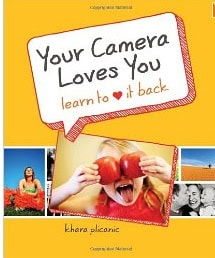Smile, Your Camera Loves You: Learn to Love It Back
By Peter Sacco
 They say a picture is worth a thousand words. In travel, make that two thousand. That’s why the articles we publish are surrounded by so many images.
They say a picture is worth a thousand words. In travel, make that two thousand. That’s why the articles we publish are surrounded by so many images.
Good photography and understanding your new camera isn’t as difficult as it seems. And for those of us who need a subtle nudge in the right direction, there is Your Camera Loves You, a new book by by Khara Plicanic. (view her photos at the link, this gal can really shoot!–Ed)
This easy to read and informative book spells out fancy camera terminology, and is packed full of applicable and practical information. Pictures don’t lie, and for travelers they provide the ultimate means to bring home and flaunt that crazy adventure abroad.
Today, cameras can appear a bit intimidating. They come equipped with fancy lenses, inch-thick guide books, and often look far more like war equipment than the traveler’s best friend.
An Excerpt from Plicanic’s book:
“Remember that scene in The Wizard of Oz when Toto pulls back the green curtain and we all see that the man behind ‘all powerful Oz isn’t nearly as scary as everyone thought? In fact, he turned out to be kind of sweet, even offering to fly Dorothy home in his hot air balloon.
Think of this chapter as your own look ‘behind the curtain’. While you won’t find a sparkling Emerald City, you’ll find your way to an understanding to ‘the magic’ that happens with every photo you take.
A lot of things happen in an instant when you press the shutter button and they all directly impact the resulting photo- whether it pleasantly surprises you, is just what you were expecting, or leaves you shaking your head and aiming to try again. A little bit of understanding goes a long way towards helping you get the results you want (without requiring a PhD in camera technology, thankfully). As sophisticated as today’s cameras are, in many ways they are actually still quite simple. So don’t let the bells, whistles, and mountains of megapixles fool you. The mechanics of photography haven’t changed and are simpler than you’d think- I promise!
Every photo you take is a direct result of three things known as shutter speed, aperture, and ISO. Each one controls a single aspect of how the resulting image will look.
You may be relieved to know that there’s no right or wrong answer when it comes to how to combine these three variables- as long as you get an exposure (aka: picture) you’re happy with.
Shutter Speed controls time and motion, and how much of it gets recorded in a single photo.
Shutter = Eyelid
If we compare a camera to the human eye, the shutter would be the equivalent to your eyelid. The shutter- which can open and close in a fraction of a second, or much slower- is directly responsible for the incredible images you’ve seen of blurred waterfalls and streaked car lights as well as pictures of exploding balloons and your favorite sports hero, frozen in time.
Typically measured in fractions of a second, the shutter sped controls the length of time light is allowed to access the camera’s sensor (where the image is actually captured). In other words, it controls how long the camera’s eye is open, so to speak. For example, a shutter speed of 1/500th of a second means that when you take a picture, the shutter will be open and the camera will be recording (exposing) for exactly 1/500th of a second.
Minimum and maximum shutter speeds vary, and may range from as fast as 1/8000th of a second to as slow as several seconds or even hours. Some cameras also include a shutter speed setting called ‘bulb’, where the shutter will stay open for as long as you continue to hold the shutter down. Neato!
Slower shutter speeds result in moving objects being recorded as blurry streaks- so if you want to convey movement or the passing of time in a photo, you choose a slower shutter speed. How slow? The answer depends on what you’re shooting, and how blurred you want it to be. The only way to know for sure is to experiment. You might start with a shutter speed of 1/15th, and later discover through trial and error that you prefer the effects of a full four-second exposure, or something even longer. Depending on how slow you go, you may require the use of a tripod.
Freezing Your Subjects
Conversely, faster shutter speeds allow you to seemingly stop time by freezing your subjects. Whether trying to capture your two-year-old toddler, your daughter’s basketball game, or anything else on the move, a faster shutter speed makes it possible. How fast exactly? Well, just as before, it depends. You’ll need to consider how fast your subject is moving and then- experiment!
Aperture controls the amount of light that passes through the lens, as well as something called ‘depth of field’.
As long as we’re comparing cameras to human eyes, we might also say that the aperture is akin to your pupil. Just as your pupil dilates or constricts in response to different lighting conditions, aperture is an opening inside your lens that can be set wide to let in more light, or closed down to let in less light.

Measured in something called ‘f-stops’, aperture controls how much light is allowed to pass through the camera lens on its way to the sensor. In darker shooting conditions, the aperture might be opened wider to allow more light to reach the sensor, while brighter lighting environments may require the aperture to be closed down to keep light out.
Unlike shutter speed, which relates to the camera body itself, aperture is a function of the lens. Therefore, the f-stop range available to you will vary from one lens to the next.
Because aperture values are really fractions (for the curious minds out there, the formula is focal length divided by effective diameter), the smaller numbers are actually wider openings than the bigger numbers. Thus, a setting of f/2.8 is wider and lets in more light than f/11 does.
Not only does aperture control how much light passes through the lens, but it also has the power to direct the viewer’s attention by controlling something called ‘depth of field’.
Depth of Field
A deep depth of field ensures that both the foreground and background will appear in focus, whereas a shallow depth of field makes it possible for the subject to be in focus while the foreground and background are not.
Wider aperture openings, therefore, not only let in more light, but they also create a shallower depth of field, allowing more of the foreground and background to be in focus.
To help you remember and make sense of this all, just ask yourself this question: When you’re in the car driving down the highway, and you attempt to read a sign far off in the distance, what do you do?
You squint. We instinctively try to expand our focal range by literally making our eyes smaller (not sure if it really helps you read the road sign, but it does make a really great analogy!). Aperture works the same way. The smaller the opening, the bigger the focal range, and vice versa.
No one said this had to be complicated!
ISO controls the camera’s sensitivity to light. It’s the digital equivalent of film speed.
Back in the day, we bought different rolls of film for different kinds of shooting situations. For most people, this meant a last minute trip to the drug store only to end up standing in the checkout isle confused about which box to buy. Should you get 800 or 200 speed? 24 exposures or 36? Such decisions! And whatever you bought, you were stuck with it until you finished the role.
Thankfully, we no longer need to stand in the drug store, scratching our heads in a quandary about which film to purchase, nor do we need to finish a whole roll before switching to something that might be more appropriate for a given shooting situation. With digital, you can change the ISO from one photo to the next.
The available ISO range varies from camera to camera, but a typical example might be from 100 to 1600 or higher. The higher the number, the more sensitive the camera’s sensor becomes. Thus, a low setting such as ISO100 will require more light to make a photo than a higher setting such as ISO1600 would.”
Peter Sacco is an editorial assistant at GoNOMAD. Read more of his articles on his GoNOMAD author page.
Buy this book on Amazon Your Camera Loves You: Learn to Love It Back
- Valentine’s Day Suggestions…for that Special Person - January 22, 2026
- Missouri Sports Travel Adventure: From Landmarks to Ballparks - January 21, 2026
- What First-Time Visitors Get Wrong About Visiting Iceland - January 15, 2026







